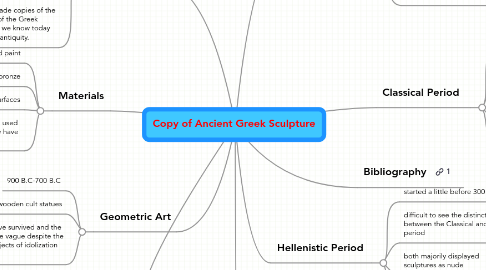Copy of Ancient Greek Sculpture
par Chelsea Jackson


1. Basic Facts
1.1. Greeks portrayed the gods in very similar fashion as they did the regular humans
1.1.1. This is also similar in Greek stories, where the gods are shown to have very human characteristics, both good and bad.
1.2. There were no distinctions of size or body make up in their sculpture which would suggest that the gods where greater or more powerful then the humans
1.3. basis of the sculpture in Rome
1.4. If the Romans had not made copies of the Greek sculptures, many of the Greek Legends and stories that we know today would have been lost to antiquity.
2. Materials
2.1. stone and paint
2.2. marble and bronze
2.3. had multicolored surfaces
2.3.1. traces of this are hard to find today
2.4. Other materials such as clay were also used but due to their brittle nature very few have survived
3. Geometric Art
3.1. 900 B.C-700 B.C
3.2. wooden cult statues
3.3. None of the statues have survived and the descriptions of them are vague despite the fact that some were objects of idolization for hundreds of years
4. Nudity
4.1. Perfect Form
4.2. Building steps to clothing
4.3. young athletes
5. Archaic Period
5.1. 600 B.C-480 B.C
5.2. influenced by work of egyptians
5.3. creating perfection in human form
5.4. rigid and unnatural
5.5. blank faces
5.6. Greeks were the first to create free-standing statues in this period of time
6. Classical Period
6.1. 5th to 4th century B.C
6.2. contrapposto stance
6.2.1. one leg is extended and the imaginary shift in weight is modeled into the statue to convey a sense of gravity and enhance the realism of the piece.
6.3. Females were depicted nude
6.4. Flowing robes
6.4.1. The robes gave the sculpture the idea of movement and realism in an effort by the artist to show humans more realistically.
7. Bibliography
8. Hellenistic Period
8.1. started a little before 300 B.C
8.2. difficult to see the distinctions between the Classical and Hellenistic period
8.3. both majorily displayed sculptures as nude
8.4. a young, vigorous, and athletic person
8.4.1. attempted to capture the idea of youth and strength in their design
9. Sculptors
9.1. Phidias
9.1.1. Athena in Parthenon
9.2. Praxiteles
9.2.1. Aphrodite at Knidos
9.2.2. Hermes with the Infant Dionysus
9.3. Lysippus
9.3.1. Alexander the Great
9.4. Myron
9.4.1. Discobolus
